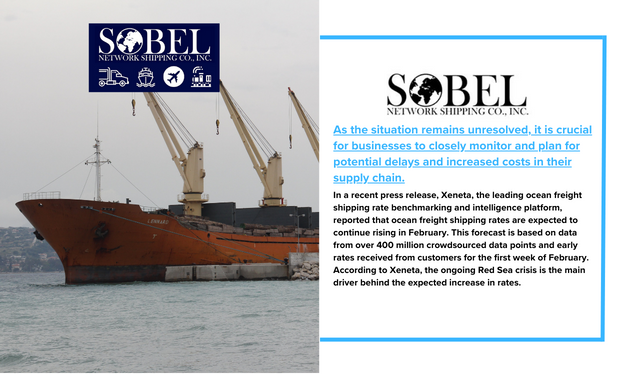Ocean Freight Shipping Rates Forecast to Rise Further in February
In a recent press release, Xeneta, the leading ocean freight shipping rate benchmarking and intelligence platform, reported that ocean freight shipping rates are expected to continue rising in February. This forecast is based on data from over 400 million crowdsourced data points and early rates received from customers for the first week of February.
According to Xeneta, the ongoing Red Sea crisis is the main driver behind the expected increase in rates. The crisis, which began in mid-December, has caused rates to skyrocket, with short-term rates from the Far East to the Mediterranean increasing by 243% and rates from the Far East to North Europe increasing by 235%. The most significant increase is seen in rates from the Far East to the U.S. East Coast, which are expected to rise by 17% by February 2, bringing the average short-term rate to $6119 per FEU (forty-foot equivalent unit).
Xeneta Chief Analyst Peter Sand explains that carriers are trying to adjust their services to make up for the additional sailing time caused by the Red Sea crisis. This includes cutting journeys short, missing port calls, and increasing sailing speed. However, despite these efforts, early data suggests that rates will continue to rise as we head into February.
Sand also notes that carriers are no longer offering premium services that guarantee shipment during times of extreme pressure on available capacity. This could be due to a decline in demand or the availability of capacity despite the chaos caused by carriers pausing transits through the Suez Canal.
The Red Sea crisis, which has brought heightened tensions across the region, is causing a capacity issue rather than a demand issue. This has led to instability and uncertainty in the market, and Xeneta’s data shows that rates are expected to continue rising as the situation remains unresolved.
In a previous press release, Xeneta warned that the recent missile strikes by the U.S. and UK against Houthi militia in Yemen could further disrupt ocean freight shipping. Sand stated that the situation must calm down for safe and risk-free voyages to occur, but in the short term, disruption to ocean freight shipping is expected to worsen.
Sand also noted that the longer the crisis continues, the more disruption and rising costs it will cause for ocean freight shipping around the globe. This could result in delayed or canceled shipments and ultimately lead to increased prices for consumers.
While tension in the Middle East is not new, the ongoing crisis in the Red Sea is expected to continue for months, rather than weeks or days. Sand warns that we cannot rule out any further escalations, and it is unlikely that we will see similar events in the Strait of Hormuz.
In conclusion, Xeneta’s latest data shows that ocean freight shipping rates are expected to continue rising in February due to the ongoing Red Sea crisis. The uncertainty and instability caused by the crisis have led to a capacity issue, resulting in increased rates and potential disruptions to ocean freight shipping.


